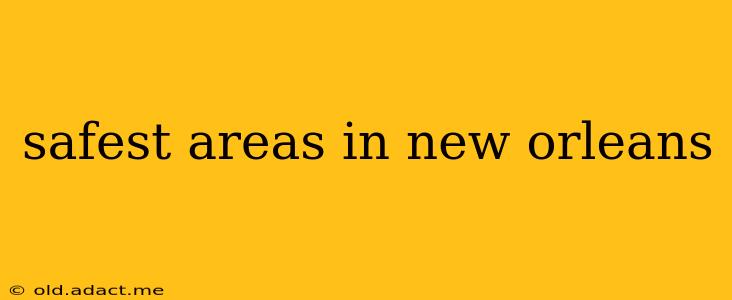New Orleans, a city renowned for its vibrant culture, rich history, and delectable cuisine, also has areas with varying levels of safety. While no city is entirely free from crime, certain neighborhoods consistently boast lower crime rates than others. This guide will delve into the safest areas in New Orleans, providing you with the information you need to plan a safe and enjoyable trip or consider relocation. We'll explore factors influencing safety and offer tips for staying safe wherever you are in the city.
What Makes an Area "Safe"?
Before we dive into specific neighborhoods, it's crucial to understand what constitutes a "safe" area. Safety is multifaceted and goes beyond simply looking at crime statistics. Factors contributing to a neighborhood's safety profile include:
- Crime Rates: This is a primary indicator, encompassing violent crimes (murder, robbery, assault) and property crimes (burglary, theft). Official crime statistics from sources like the New Orleans Police Department (NOPD) are valuable. However, remember that statistics often represent past trends and don't predict the future perfectly.
- Community Engagement: Areas with strong community involvement, active neighborhood watch programs, and good relationships between residents and law enforcement often experience lower crime rates.
- Infrastructure: Good street lighting, well-maintained public spaces, and a visible police presence can deter crime and enhance safety.
- Economic Factors: Socioeconomic factors, such as poverty and unemployment, can be correlated with higher crime rates, though correlation doesn't equal causation.
Safest Areas in New Orleans: A Neighborhood Breakdown
While "safest" is subjective and changes over time, several New Orleans neighborhoods consistently rank higher in terms of safety:
-
The Garden District: Known for its stunning architecture, lush gardens, and upscale boutiques, the Garden District offers a relatively safe environment with a strong community feel. The area's affluence and well-maintained infrastructure contribute to its higher safety rating.
-
Uptown (Specific Sections): Uptown encompasses a large area, and safety levels can vary significantly. However, certain sections of Uptown, particularly those closer to the Garden District and Audubon Park, generally enjoy lower crime rates. Audubon Park itself is typically very safe, especially during daylight hours.
-
Lakeview: Located on the shores of Lake Pontchartrain, Lakeview boasts a family-friendly atmosphere with a relatively low crime rate. The area's strong community ties contribute to its safe environment.
-
Metairie (Jefferson Parish): While technically not in New Orleans proper, Metairie, located in Jefferson Parish, is often considered a safe and desirable suburb. It offers a quieter, residential atmosphere with lower crime rates compared to some areas within New Orleans city limits.
It's important to note that even within these areas, it's crucial to exercise caution, especially at night.
Are there certain times of day that are safer than others?
Yes, generally, daylight hours are safer than nighttime in any urban area. Crimes of opportunity, such as robberies and burglaries, are more prevalent in low-light conditions. Stick to well-lit streets and avoid walking alone at night in any part of New Orleans.
What are the riskiest neighborhoods in New Orleans?
Several areas in New Orleans have higher crime rates than others. It's best to research specific neighborhoods thoroughly before visiting or moving there. Publicly available crime statistics can be useful but should be considered alongside other factors. It's always advisable to consult up-to-date local resources and reviews.
How can I stay safe during my visit to New Orleans?
Staying safe in New Orleans involves being aware of your surroundings and taking necessary precautions:
- Stick to well-lit areas: Avoid poorly lit streets, especially at night.
- Travel in groups: Walking with a companion is always safer, especially in less populated areas.
- Be aware of your belongings: Avoid displaying expensive jewelry or electronics. Keep purses and wallets secure.
- Use ride-sharing services: Ride-sharing apps offer a safe and convenient alternative to driving or walking alone at night.
- Trust your instincts: If an area feels unsafe, leave immediately.
- Inform someone of your plans: Let someone know your itinerary, especially if you're exploring areas less familiar to you.
How do crime statistics impact insurance rates in New Orleans?
Crime rates directly influence insurance premiums in New Orleans, as they reflect the risk level associated with property and personal safety. Areas with higher crime rates typically have higher insurance costs.
Remember that this information provides a general overview. Safety conditions can fluctuate, and it's always wise to research specific neighborhoods and consult local resources before making any decisions related to visiting or living in New Orleans. This information is not exhaustive and should not be taken as definitive legal advice.
